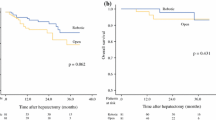Abstract
Background
A paucity of data exists on the national use of robotic hepatectomy. We assessed national trends and perioperative outcomes of robotic hepatectomy in the USA. In addition, factors associated with use of the robotic approach were analyzed.
Methods
The National Cancer Database (NCDB) was queried for patients undergoing hepatectomy from 2010 to 2016. Patients undergoing total hepatectomy for transplant were excluded. Factors associated with the use of the robotic approach were assessed using logistic regression multivariable analysis. Propensity-score analysis was performed (robotic vs. laparoscopic and robotic vs. open approaches), and perioperative outcomes were compared between the matched groups.
Results
The robotic approach was used in 287 patients (110 hospitals). Utilization of the robotic approach increased significantly on the national level from 0.8% in 2010 to 4.1% in 2016 (P<0.001). The number of hospitals performing a minimum of one robotic hepatectomy per year increased from 8 in 2010 to 35 in 2016. The median hospital length of stay was 4 days (IQR 3–6), 30-day readmission rate was 5%, and 30-day/90-day mortality rates were 3%/4%. Factors associated with using robotic approach were African-American race (95% CI 1.02–2.11), recent year of surgery (95% CI 1.11–1.32), HCC histology (95% CI 1.01–52.03), tumor size (95% CI 0.87–0.96), and early-stage tumor (Stage I-II, 95% CI 1.27–3.99). On propensity-matched analysis, there were no differences between robotic and open approaches (n=184 each group) in 30-day readmission (5% vs. 7%, P=0.651), 30-day mortality (2% vs. 4%, P=0.106), 90-day mortality (3% vs. 7%, P=0.080), or 5-year overall survival (58% vs. 43%, P=0.211). However, the robotic approach was associated with a significantly shorter hospital stay (median: 4 vs. 6 days, P<0.001). There were no differences between matched groups of patients undergoing robotic and laparoscopic approaches (n=182 in each group) in perioperative outcomes or length of hospital stay.
Conclusion
National use of robotic-assisted hepatectomy has increased by fivefold over the seven-year study period. It was associated with a shorter hospital length of stay compared to the open approach without compromising perioperative outcomes or survival.


Similar content being viewed by others
References
Leung U, Fong Y (2014) Robotic liver surgery. Hepatobiliary Surg Nutr 3(5):288–294. https://doi.org/10.3978/j.issn.2304-3881.2014.09.02
Giulianotti PC, Bianco FM, Daskalaki D, Gonzalez-Ciccarelli LF, Kim J, Benedetti E (2016) Robotic liver surgery: technical aspects and review of the literature. Hepatobiliary Surg Nutr 5(4):311–321. https://doi.org/10.21037/hbsn.2015.10.05
Cherqui D, Husson E, Hammoud R, Malassagne B, Stéphan F, Bensaid S, Rotman N, Fagniez PL (2000) Laparoscopic liver resections: a feasibility study in 30 patients. Ann Surg 232(6):753–762
Hung AJ, Patil MB, Zehnder P, Cai J, Ng CK, Aron M, Gill IS, Desai MM (2012) Concurrent and predictive validation of a novel robotic surgery simulator: a prospective, randomized study. J Urol 187(2):630–637
Steinberg PL, Merguerian PA, Bihrle W 3rd, Heaney JA, Seigne JD (2008) A da Vinci robot system can make sense for a mature laparoscopic prostatectomy program. JSLS 12(1): 9–12
Turchetti G, Palla I, Pierotti F, Cuschieri A (2012) Economic evaluation of da Vinci-assisted robotic surgery: a systematic review. Surg Endosc 26(3):598–606
Yu Y-D, Kim K-H, Jung D-H et al (2014) Robotic versus laparoscopic liver resection: a comparative study from a single center. Langenbeck’s Arch Surg 399(8):1039–1045
Packiam V, Bartlett DL, Tohme S et al (2012) Minimally invasive liver resection: robotic versus laparoscopic left lateral sectionectomy. J Gastroint Surg 16(12):2233–2238
Pagistri P, Guerrini GP, Ballarin R, Assirati G, Tarantino G, Di Benedetto F (2019) Improving outcomes defending patient safety: the learning journey in robotic liver resections. BioMed Res Int 2019
Szold A, Bergamaschi R, Broeders I et al (2015) European association of endoscopic surgeons (EAES) consensus statement on the use of robotics in general surgery. Surg Endosc 20(2):253–288
Gonzalez-Ciccarelli LF, Quadri P, Daskalaki D, Milone L, Gangemi A, Giulianotti PC (2017) Robotic approach to hepatobiliary surgery. Chir Z Geb Oper Med 88(Suppl 1):19–28
American College of Obstetricians and Gynecologists (2009) ACOG Technology assessment in obstetrics and gynecology No. 6: robot-assisted surgery. Obstet Gynecol 114: 1153–1155
Erickson BK, Gleason JL, Huh WK, Richter HE (2012) Survey of robotic surgery credentialing requirements for physicians completing OB/GYN residency. J Minim Invasive Gynecol 19(5):589–592. https://doi.org/10.1016/j.jmig.2012.05.003
Author information
Authors and Affiliations
Corresponding author
Additional information
Publisher's Note
Springer Nature remains neutral with regard to jurisdictional claims in published maps and institutional affiliations.
Rights and permissions
About this article
Cite this article
Kamel, M.K., Tuma, F., Keane, C.A. et al. National Trends and Perioperative Outcomes of Robotic-assisted Hepatectomy in the USA: A Propensity-score Matched Analysis from the National Cancer Database. World J Surg 46, 189–196 (2022). https://doi.org/10.1007/s00268-021-06315-w
Accepted:
Published:
Issue Date:
DOI: https://doi.org/10.1007/s00268-021-06315-w




